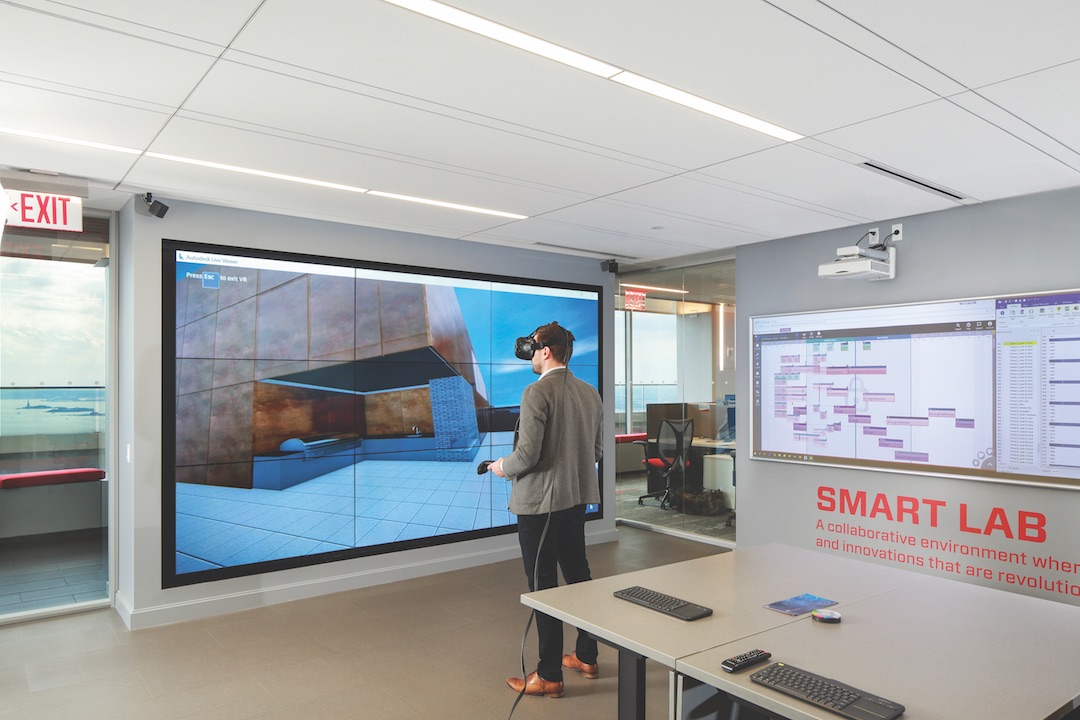As BIM/VDC adoption rates have accelerated substantially over the last decade, helping to usher the design and construction industry into the digital age, a slew of heralded technologies—from VR to computational design—has emerged to reveal that the AEC world is ripe for a seismic disruption.
At the center of this tech infusion is the smart jobsites movement. BD+C caught up with three construction giants—Suffolk Construction, Robins & Morton, and Hoar Construction—to learn about their latest smart jobsite strategies. Here’s what they had to share:
SUFFOLK’S SMART LABS
Taking inspiration from the science and technology industries, Suffolk Construction has created dedicated spaces, called Smart Labs, to capture and study data, collaborate across project teams, and test new technologies and processes. The firm’s first such space came on line in June 2017, in its San Francisco office, followed by New York and Boston late last year. Labs are opening in Miami and Tampa, Fla., this month, with Los Angeles in the queue.
The Smart Labs function as “operational control towers” that allow Suffolk executives to monitor their projects nationwide in real-time, giving them progress updates and financial data. Each lab has massive video screens across a data wall, with live camera feeds from all 90 of Suffolk’s current jobsites. The labs are also equipped with a CAVE virtual reality area, where team members, clients, and prospects can review projects in immersive 3D environments.
The intent of this first-of-its-kind initiative in AEC is to serve as an ecosystem to harness data to proactively stave off construction problems and to better anticipate scheduling and materials needs. The labs help Suffolk executives make best use of organizational talent and minimize waste and inefficiency by removing the high levels of unpredictability that accompany fluid construction environments.
 Suffolk’s Smart Labs function as “operational control towers” that allow the firm’s executives to monitor their projects nationwide in real-time, giving them progress updates and financial data. Suffolk Construction.
Suffolk’s Smart Labs function as “operational control towers” that allow the firm’s executives to monitor their projects nationwide in real-time, giving them progress updates and financial data. Suffolk Construction.
“Information in context is much more powerful than information that is plugged in one data point at a time,” says Chris Mayer, Suffolk’s Chief Innovation Officer. “We take this collection of information and have data-enabled meetings across project teams, where we can then fine-tune our forecasting, staffing, planning, and control process to be as close to our customers needs as possible.”
Mayer says the firm’s long-term plans involve writing custom code and developing algorithms that will help better pinpoint service delivery.
ROBINS & MORTON’S SLATPLANNER
Frustrated by the limitations of analog production planning systems, Steve Moore, PMP, PSP, LEED AP, Division Scheduling Manager with Robins & Morton, realized that there was an opportunity to invent a hybrid system. Developed over nine months, he set out to create an offering that allows for the hands-on elements of scheduling (i.e., arranging sticky notes on a wallboard), which encourage collaboration, with a digitized method for collecting and analyzing important project-related data.
SlatPlanner, currently in beta testing, is Moore’s brainchild that enables the scanning of all information arranged on a wallboard and then allows users to see a history of activity that shows the percentage of planned vs. completed work, lists failure reasons, tracks manpower allocation, and automates overall plan feasibility to help eliminate some of the scheduling gaps and guess work.
The subscription-based offering is expected to launch this June, at the AEC NEXT Technology Expo and Conference in Anaheim, Calif.
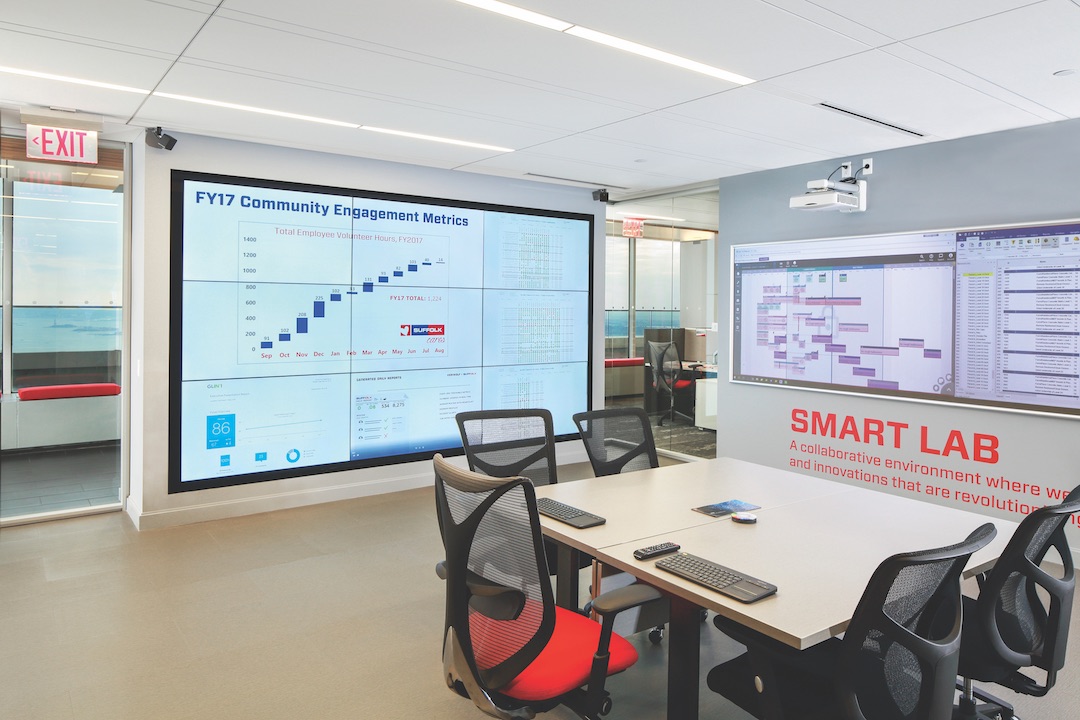 By mid-2018, the company expects to have six Smart Labs operational at its offices across the country, including in Boston, Los Angeles, Miami, and New York. One of the featured software is from TouchPlan, seen on the right side of the image above. Suffolk Construction.
By mid-2018, the company expects to have six Smart Labs operational at its offices across the country, including in Boston, Los Angeles, Miami, and New York. One of the featured software is from TouchPlan, seen on the right side of the image above. Suffolk Construction.
To be more Lean-focused, Robins & Morton recently implemented delivery scheduling software from Voyage Control. The firm’s Logistics Superintendent, Rusty Bratcher, explains that the impetus for adopting the software came out of a logistically complex project for the Medical University of South Carolina, in Charleston.
“The campus is tightly situated in downtown Charleston and is subjected to heavy amounts of pedestrian and automobile traffic, along with ambulances needing to get in and out quickly at all hours of the day,” says Bratcher. “There were big concerns about being efficient across numerous delivery points on site, but for also creating problematic congestion in a cramped environment that includes a busy parking garage.”
To keep from impacting downtown traffic patterns, the Robins & Morton team scheduled all deliveries during the second shift, and none earlier than 5:30 p.m. Having previously used a basic spreadsheet for scheduling deliveries, the firm felt it needed something more sophisticated to maximize efficiencies.
Bratcher says the cloud-based software has eliminated the bottlenecks of crowded gate arrivals with a backlog of trucks waiting to unload their supplies. The firm is able to pinpoint delivery times and coordinate trucks in single-file formation, while knocking out wasted downtime for drivers in the process. Bratcher can book deliveries months in advance, so the team can work around the times when it has shipments that require an elevator.
During the first two months of 2018, Bratcher says the firm used the Voyage Control software for approximately 600 deliveries, with marked improvement over its traditional delivery scheduling method: 83% on-time deliveries vs. 45% with the spreadsheet approach.
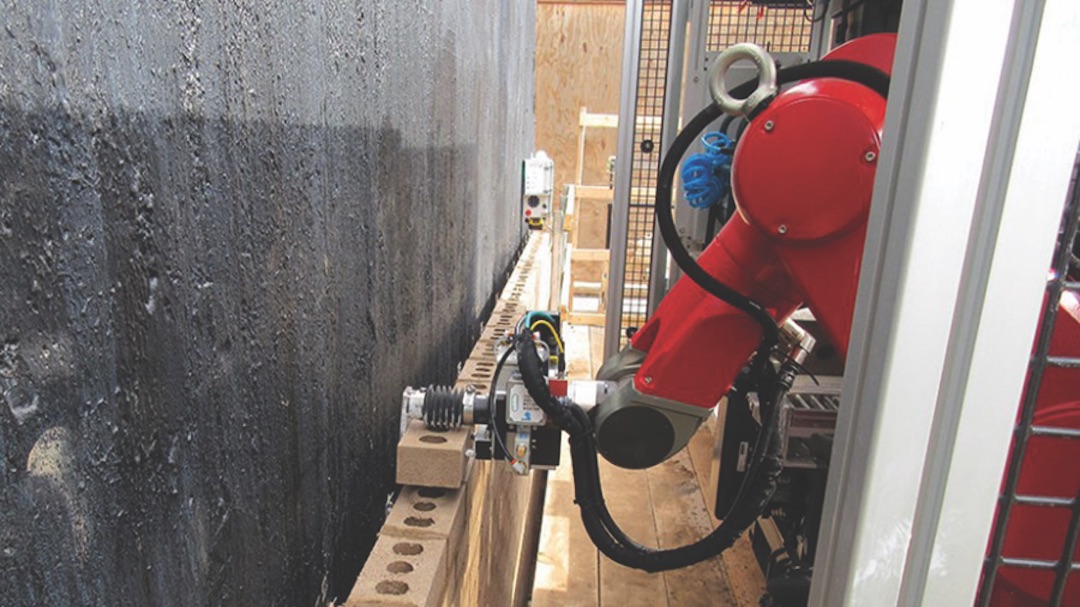 Hoar Construction is exploring the use of robotics to improve productivity, including a test run of a Semi-Automated Mason (SAM) on the Poff Federal Building project in Roanoke, Va., which required 470,000 bricks. The machine set 3,000 bricks per day—six times faster than a single mason—and improved overall consistency, according to the firm. Hoar Construction.
Hoar Construction is exploring the use of robotics to improve productivity, including a test run of a Semi-Automated Mason (SAM) on the Poff Federal Building project in Roanoke, Va., which required 470,000 bricks. The machine set 3,000 bricks per day—six times faster than a single mason—and improved overall consistency, according to the firm. Hoar Construction.
HOAR CONSTRUCTION’S CLOUD-BASED PM
Project management is an area that has been ripe for improvement, with a need for greater collaboration and communication among builders, subcontractors, and clients. Hoar Construction recently replaced a mixed bag of project management and field and document management systems with the Procore construction platform.
Paul Walker, Hoar’s Vice President of Information Technology, explains that the consolidation, while “basically a wash” from a cost-savings perspective, has helped the construction giant manage its project data. “What’s important to me is that 10 years from now, I know that we will have our crucial data in one place, and that allows me to sleep better at night,” says Walker.
An added benefit, he says, is the elimination of “tool fatigue” that came with Hoar team members having to learn numerous systems and apps for different needs in their daily routines. This has resulted in greater buy-in (important for morale and productivity) across project teams.
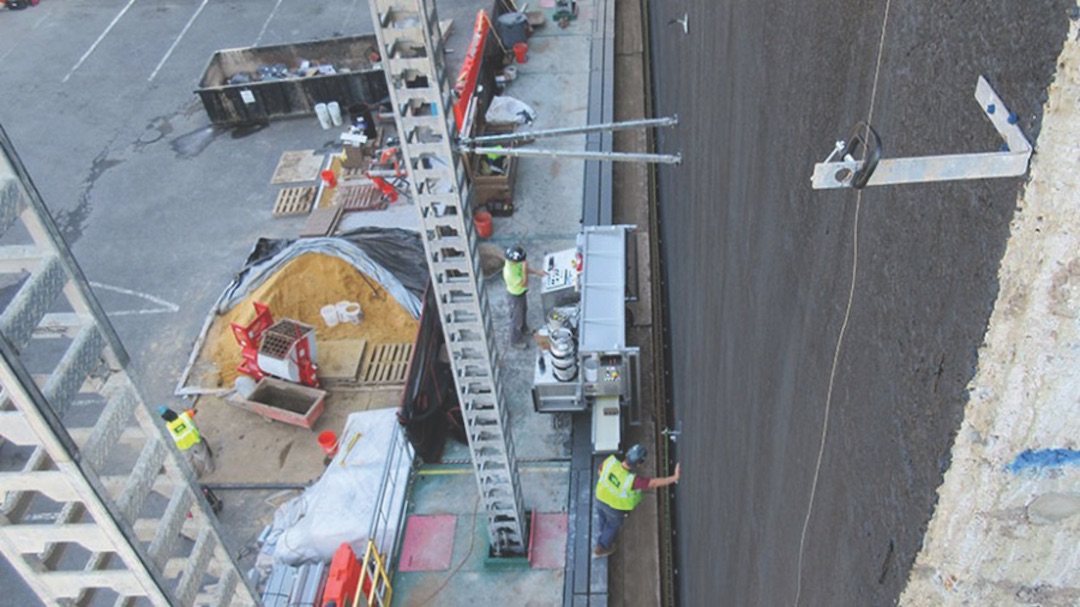 Hoar Construction.
Hoar Construction.
Hoar is also leveraging consumer-driven technology to help enhance client experiences throughout the construction process. Google Street View allows for panoramic views from multiple vantage points, and, as client expectations have risen accordingly, Hoar has deployed 3D scanners to apply a similar capability to its projects.
The 3D scanner initiative has replaced the time and expense of taking weekly and monthly progress still photos. Instead, the 360-degree imagery allows for capture and tagging of all areas within a project. From there, tagged photos can be uploaded and shared through the Procore platform, giving all end-users true visibility in one system.
The digital documentation improves quality control and has eliminated the need for cumbersome binders full of project documents. Clients can quickly find “as-built” updates and take virtual walkthroughs of the project.
Hoar is also exploring the use of robotics to improve productivity, giving a test run to a Semi-Automated Mason (SAM) on a project requiring 470,000 bricks. The tool set 3,000 bricks per day—six times faster than a single mason—and has improved overall consistency. As this technology matures, Walker expects robotics to be used for jobs such as laying tile and increasing the precision of core drilling through concrete slabs.
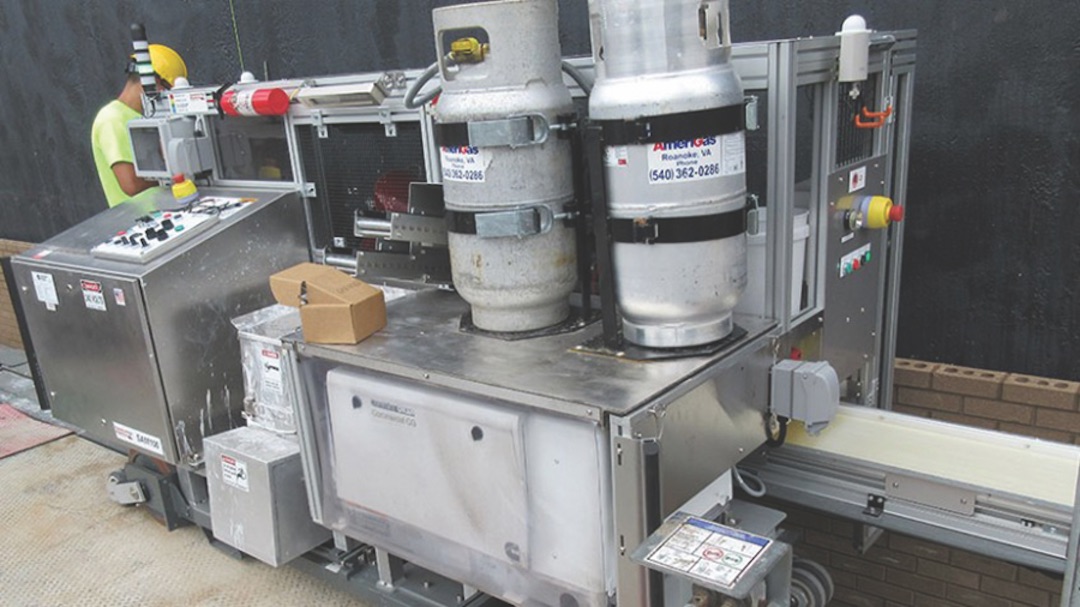 Hoar Construction.
Hoar Construction.
Related Stories
Contractors | Mar 12, 2024
The average U.S. contractor has 8.1 months worth of construction work in the pipeline, as of February 2024
Associated Builders and Contractors reported that its Construction Backlog Indicator declined to 8.1 months in February, according to an ABC member survey conducted Feb. 20 to March 5. The reading is down 1.1 months from February 2023.
Museums | Mar 11, 2024
Nebraska’s Joslyn Art Museum to reopen this summer with new Snøhetta-designed pavilion
In Omaha, Neb., the Joslyn Art Museum, which displays art from ancient times to the present, has announced it will reopen on September 10, following the completion of its new 42,000-sf Rhonda & Howard Hawks Pavilion. Designed in collaboration with Snøhetta and Alley Poyner Macchietto Architecture, the Hawks Pavilion is part of a museum overhaul that will expand the gallery space by more than 40%.
Affordable Housing | Mar 11, 2024
Los Angeles’s streamlined approval policies leading to boom in affordable housing plans
Since December 2022, Los Angeles’s planning department has received plans for more than 13,770 affordable units. The number of units put in the approval pipeline in roughly one year is just below the total number of affordable units approved in Los Angeles in 2020, 2021, and 2022 combined.
BIM and Information Technology | Mar 11, 2024
BIM at LOD400: Why Level of Development 400 matters for design and virtual construction
As construction projects grow more complex, producing a building information model at Level of Development 400 (LOD400) can accelerate schedules, increase savings, and reduce risk, writes Stephen E. Blumenbaum, PE, SE, Walter P Moore's Director of Construction Engineering.
AEC Tech | Mar 9, 2024
9 steps for implementing digital transformation in your AEC business
Regardless of a businesses size and type, digital solutions like workflow automation software, AI-based analytics, and integrations can significantly enhance efficiency, productivity, and competitiveness.
Sports and Recreational Facilities | Mar 7, 2024
Bjarke Ingels’ design for the Oakland A’s new Las Vegas ballpark resembles ‘a spherical armadillo’
Designed by Bjarke Ingels Group (BIG) in collaboration with HNTB, the new ballpark for the Oakland Athletics Major League Baseball team will be located on the Las Vegas Strip and offer panoramic views of the city skyline. The 33,000-capacity covered, climate-controlled stadium will sit on nine acres on Las Vegas Boulevard.
Adaptive Reuse | Mar 7, 2024
3 key considerations when converting a warehouse to a laboratory
Does your warehouse facility fit the profile for a successful laboratory conversion that can demand higher rents and lower vacancy rates? Here are three important considerations to factor before proceeding.
Shopping Centers | Mar 7, 2024
How shopping centers can foster strong community connections
In today's retail landscape, shopping centers are evolving beyond mere shopping destinations to become vibrant hubs of community life. Here are three strategies from Nadel Architecture + Planning for creating strong local connections.
Market Data | Mar 6, 2024
Nonresidential construction spending slips 0.4% in January
National nonresidential construction spending decreased 0.4% in January, according to an Associated Builders and Contractors analysis of data published today by the U.S. Census Bureau. On a seasonally adjusted annualized basis, nonresidential spending totaled $1.190 trillion.
MFPRO+ Research | Mar 6, 2024
Top 10 trends in senior living facilities for 2024
The 65-and-over population is growing faster than any other age group. Architects, engineers, and contractors are coming up with creative senior housing solutions to better serve this burgeoning cohort.


